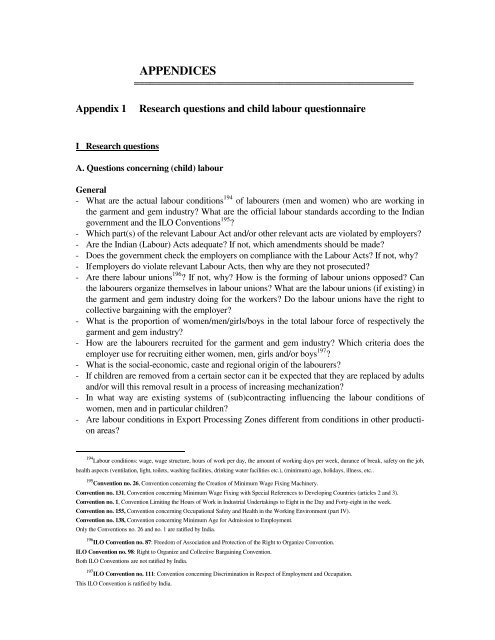Create successful ePaper yourself
Turn your PDF publications into a flip-book with our unique Google optimized e-Paper software.
APPENDICES<br />
════════════════════════════════════════════════════<br />
Appendix 1<br />
Research questions <strong>and</strong> child <strong>labour</strong> questionnaire<br />
I Research questions<br />
A. Questions concern<strong>in</strong>g (child) <strong>labour</strong><br />
General<br />
- What are <strong>the</strong> actual <strong>labour</strong> conditions 194 <strong>of</strong> <strong>labour</strong>ers (men <strong>and</strong> women) who are work<strong>in</strong>g <strong>in</strong><br />
<strong>the</strong> <strong>garment</strong> <strong>and</strong> <strong>gem</strong> <strong>in</strong>dustry? What are <strong>the</strong> <strong>of</strong>ficial <strong>labour</strong> st<strong>and</strong>ards accord<strong>in</strong>g to <strong>the</strong> <strong>India</strong>n<br />
government <strong>and</strong> <strong>the</strong> ILO Conventions 195 ?<br />
- Which part(s) <strong>of</strong> <strong>the</strong> relevant Labour Act <strong>and</strong>/or o<strong>the</strong>r relevant acts are violated by employers?<br />
- Are <strong>the</strong> <strong>India</strong>n (Labour) Acts adequate? If not, which amendments should be made?<br />
- Does <strong>the</strong> government check <strong>the</strong> employers on compliance with <strong>the</strong> Labour Acts? If not, why?<br />
- If employers do violate relevant Labour Acts, <strong>the</strong>n why are <strong>the</strong>y not prosecuted?<br />
- Are <strong>the</strong>re <strong>labour</strong> unions 196 ? If not, why? How is <strong>the</strong> form<strong>in</strong>g <strong>of</strong> <strong>labour</strong> unions opposed? Can<br />
<strong>the</strong> <strong>labour</strong>ers organize <strong>the</strong>mselves <strong>in</strong> <strong>labour</strong> unions? What are <strong>the</strong> <strong>labour</strong> unions (if exist<strong>in</strong>g) <strong>in</strong><br />
<strong>the</strong> <strong>garment</strong> <strong>and</strong> <strong>gem</strong> <strong>in</strong>dustry do<strong>in</strong>g for <strong>the</strong> workers? Do <strong>the</strong> <strong>labour</strong> unions have <strong>the</strong> right to<br />
collective barga<strong>in</strong><strong>in</strong>g with <strong>the</strong> employer?<br />
- What is <strong>the</strong> proportion <strong>of</strong> women/men/girls/boys <strong>in</strong> <strong>the</strong> total <strong>labour</strong> force <strong>of</strong> respectively <strong>the</strong><br />
<strong>garment</strong> <strong>and</strong> <strong>gem</strong> <strong>in</strong>dustry?<br />
- How are <strong>the</strong> <strong>labour</strong>ers recruited for <strong>the</strong> <strong>garment</strong> <strong>and</strong> <strong>gem</strong> <strong>in</strong>dustry? Which criteria does <strong>the</strong><br />
employer use for recruit<strong>in</strong>g ei<strong>the</strong>r women, men, girls <strong>and</strong>/or boys 197 ?<br />
- What is <strong>the</strong> social-economic, caste <strong>and</strong> regional orig<strong>in</strong> <strong>of</strong> <strong>the</strong> <strong>labour</strong>ers?<br />
- If children are removed from a certa<strong>in</strong> sector can it be expected that <strong>the</strong>y are replaced by <strong>adult</strong>s<br />
<strong>and</strong>/or will this removal result <strong>in</strong> a process <strong>of</strong> <strong>in</strong>creas<strong>in</strong>g mechanization?<br />
- In what way are exist<strong>in</strong>g systems <strong>of</strong> (sub)contract<strong>in</strong>g <strong>in</strong>fluenc<strong>in</strong>g <strong>the</strong> <strong>labour</strong> conditions <strong>of</strong><br />
women, men <strong>and</strong> <strong>in</strong> particular children?<br />
- Are <strong>labour</strong> conditions <strong>in</strong> Export Process<strong>in</strong>g Zones different from conditions <strong>in</strong> o<strong>the</strong>r production<br />
areas?<br />
194 Labour conditions: wage, wage structure, hours <strong>of</strong> work per day, <strong>the</strong> amount <strong>of</strong> work<strong>in</strong>g days per week, durance <strong>of</strong> break, safety on <strong>the</strong> job,<br />
health aspects (ventilation, light, toilets, wash<strong>in</strong>g facilities, dr<strong>in</strong>k<strong>in</strong>g water facilities etc.), (m<strong>in</strong>imum) age, holidays, illness, etc..<br />
195 Convention no. 26, Convention concern<strong>in</strong>g <strong>the</strong> Creation <strong>of</strong> M<strong>in</strong>imum Wage Fix<strong>in</strong>g Mach<strong>in</strong>ery.<br />
Convention no. 131, Convention concern<strong>in</strong>g M<strong>in</strong>imum Wage Fix<strong>in</strong>g with Special References to Develop<strong>in</strong>g Countries (articles 2 <strong>and</strong> 3).<br />
Convention no. 1, Convention Limit<strong>in</strong>g <strong>the</strong> Hours <strong>of</strong> Work <strong>in</strong> Industrial Undertak<strong>in</strong>gs to Eight <strong>in</strong> <strong>the</strong> Day <strong>and</strong> Forty-eight <strong>in</strong> <strong>the</strong> week.<br />
Convention no. 155, Convention concern<strong>in</strong>g Occupational Safety <strong>and</strong> Health <strong>in</strong> <strong>the</strong> Work<strong>in</strong>g Environment (part IV).<br />
Convention no. 138, Convention concern<strong>in</strong>g M<strong>in</strong>imum Age for Admission to Employment.<br />
Only <strong>the</strong> Conventions no. 26 <strong>and</strong> no. 1 are ratified by <strong>India</strong>.<br />
196 ILO Convention no. 87: Freedom <strong>of</strong> Association <strong>and</strong> Protection <strong>of</strong> <strong>the</strong> Right to Organize Convention.<br />
ILO Convention no. 98: Right to Organize <strong>and</strong> Collective Barga<strong>in</strong><strong>in</strong>g Convention.<br />
Both ILO Conventions are not ratified by <strong>India</strong>.<br />
197 ILO Convention no. 111: Convention concern<strong>in</strong>g Discrim<strong>in</strong>ation <strong>in</strong> Respect <strong>of</strong> Employment <strong>and</strong> Occupation.<br />
This ILO Convention is ratified by <strong>India</strong>.


















